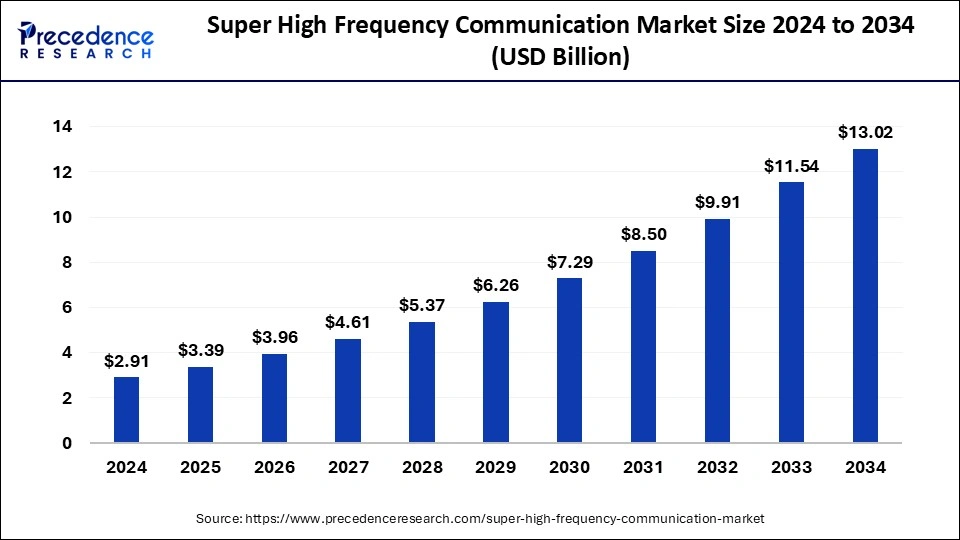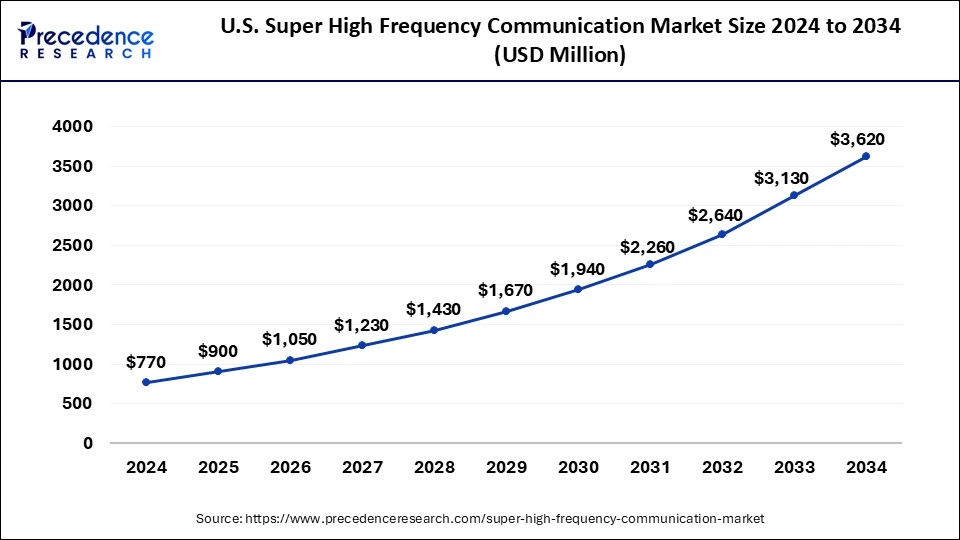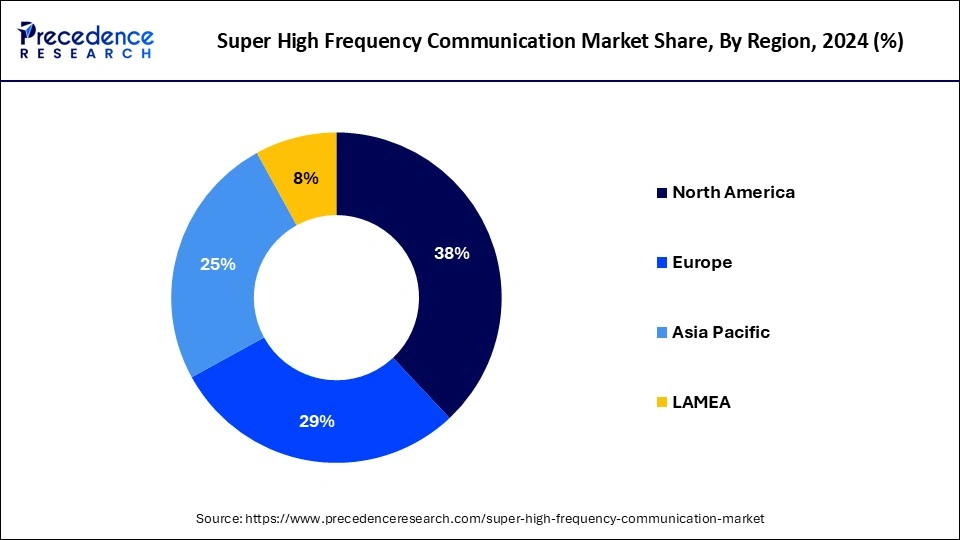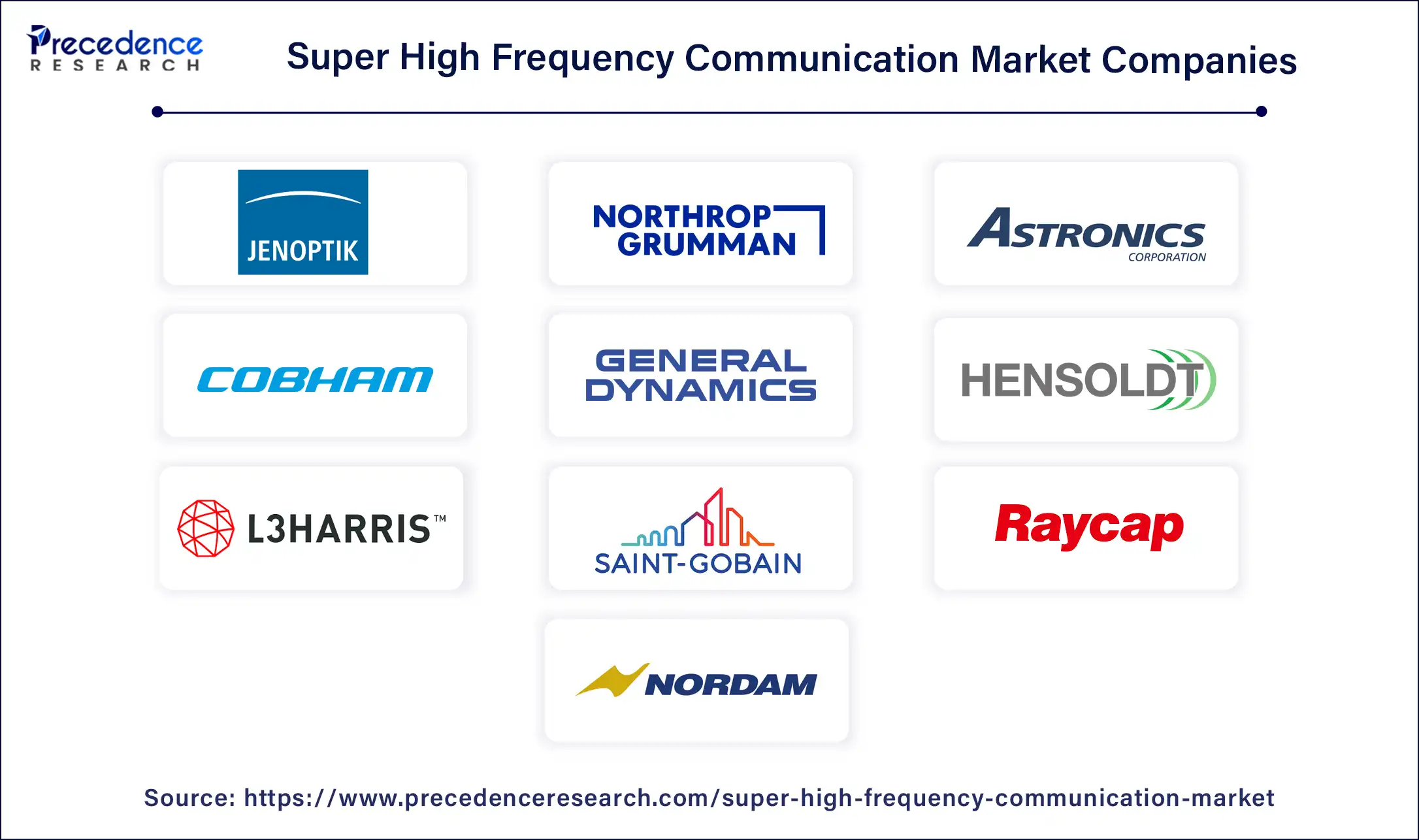List of Contents
Super High Frequency Communication Market Size and Forecast 2025 to 2034
The global super high frequency communication market size was estimated at USD 2.91 billion in 2024 and is predicted to increase from USD 3.39 billion in 2025 to approximately USD 13.02 billion by 2034, expanding at a CAGR of 16.16% from 2025 to 2034. The growing demand for high-frequency communications in a wide range of military applications is expected to drive the growth of the global super high frequency communication market during the forecast period.

Super High Frequency Communication Market Key Takeaways
- The global super high frequency communication market was valued at USD 2.91 billion in 2024.
- It is projected to reach USD 13.02 billion by 2034.
- The super high frequency communication market is expected to grow at a CAGR of 16.16% from 2025 to 2034.
- North America dominated the market with the largest revenue share of 38% in 2024.
- Asia Pacific is expected to expand at the fastest CAGR of 17.53% during the forecast period.
- By technology type, the radar segment has held a major revenue share of 50% in 2024.
- By technology type, the 5g mm wave segment is expected to grow at the fastest rate during the forecast period.
- By frequency range, the 10 - 20 GHz segment accounted for the largest revenue share of 37% market in 2024.
- By frequency range, the 20 - 30 GHz segment is expected to grow at the fastest CAGR of 24.42% over the forecast period.
- By radome type, the sandwich segment has contributed more than 64% of revenue share in 2024.
- By radome type, the multi-layer system segment is projected to grow at a solid CAGR of 19.3% during the upcoming years.
U.S. Super High Frequency Communication Market Size and Growth 2025 to 2034
The U.S. super high frequency communication market size was exhibited at USD 770 million in 2024 and is projected to be worth around USD 3,620 million by 2034, poised to grow at a CAGR of 16.74% from 2025 to 2034.

North America dominated the super high frequency communication market in 2024. The region's dominance is due to the significant demand for super-high frequency in military radars, 5G radio antennas, and LEO satellite antenna systems. Furthermore, ongoing government initiatives in the U.S. and Canada to deploy next-generation radar technologies are expected to drive market growth. In North America, the U.S. held the largest market share in the super high frequency communication market, while Canada experienced the fastest growth.
- In July 2023, SpaceX announced the launch of the world's largest commercial communications satellite. a SpaceX Falcon Heavy rocket will launch Maxar Technologies' largest ever satellite, the Jupiter 3. The communications platform will join others in the Hughes Jupiter satellite fleet already in orbit, which provides broadband internet services to North and South America.

Asia Pacific is expected to host the fastest-growing super high frequency communication market during the forecast period. The growth is driven by significant investments in deploying radar antennas, advanced systems, and other technologies. In Asian part, there is a rapid expansion in the deployment of both sub-6.0GHz and 5G mm-wave equipment. However, China dominated the super high frequency communication market in terms of market share, while India experienced the fastest growth in the region.
Tsinghua University was granted a wireless frequency license and a space radio station license by China's Ministry of Industry and Information Technology (MIIT) in May 2024 for the Smart SkyNet-1 01 satellite. This allowed the university to carry out technical verification of medium-orbit wideband communication satellite synchronization.
Market Overview
The super high frequency communication market is at the forefront of technological innovation and is set to transform global communication systems. Operating within the radio frequency spectrum, SHF communication offers numerous advantages, making it essential across various industries. These technologies provide enhanced bandwidth and data transfer capabilities, which are ideal for military communication, aerospace and defense, and telecommunications. Advancements in wireless communication and the increasing adoption of IoT devices are expected to further propel the growth of the SHF communication market in the coming years.
Super High Frequency Communication Market Growth Factors
- Escalating demand for high-speed and reliable communication solutions in various industries can drive the super high frequency communication market growth.
- The rising demand for next-generation communication technologies is expected to boost the super high frequency communication market further.
- The substantial investments made by the leading satellite service providers can propel market growth soon.
- Product launches by key market players will likely help in the super high frequency communication market expansion.
Market Scope
| Report Coverage | Details |
| Market Size by 2034 | USD 13.02 Billion |
| Market Size in 2025 | USD 3.39 Billion |
| Growth Rate from 2025 to 2034 | CAGR of 16.16% |
| Largest Market | North America |
| Base Year | 2024 |
| Forecast Period | 2025 to 2034 |
| Segments Covered | Technology Type, Frequency Range, Radome Type, and Regions |
| Regions Covered | North America, Europe, Asia-Pacific, Latin America, and Middle East & Africa |
Market Dynamics
Driver
Demand for low earth orbit (LEO) satellite constellations
The low-Earth orbit (LEO) satellite market is anticipated to be driven by growing investments and technological advancements. The growing use of LEO satellites for uses like HD video conferencing, gaming, important financial transactions, and remote asset monitoring is the cause of this development. Consequently, a number of major satellite service providers are making significant investments in the global launch of LEO satellite constellations. Satellites that use ultra high frequency communication systems can benefit from high data transfer speeds, improved security, narrow beams, and fewer antennas.
As per the report published in August 2023, Larsen & Toubro (L&T) is in talks to acquire space technology from the Indian Space Research Organization (ISRO) to build launch vehicles for low earth orbit satellites (LEOs).
Restraint
Spectrum congestion
As the demand for high-frequency spectrum increases, congestion becomes a significant concern for the super high frequency communication market. The limited availability of spectrum bands for super high-frequency communication can lead to interference and reduced system efficiency, posing challenges for seamless and reliable communication. Furthermore, integrating super high-frequency communication systems into existing infrastructures can be complex. Compatibility issues and the need for specialized expertise in implementation may create challenges for organizations looking to adopt or upgrade their communication systems.
Opportunity
Satellite communication evolution
The continuous evolution of satellite communication technologies is driving growth in the super high frequency communication market. As satellites become more advanced and versatile, the demand for high-capacity data transfer via SHF systems in satellite communication applications is expected to increase. The rise in the proliferation of IoT devices across various industries necessitates robust and reliable communication systems. Super high-frequency communication, with its high-speed capabilities and low latency, is well-suited to meet the growing connectivity demands of the IoT ecosystem, presenting a lucrative opportunity for market participants.
- In April 2024, Quectel Wireless Solutions, a global IoT solutions provider, announces the launch of the Quectel BG95-S5 3GPP non-terrestrial network. Satellite communication module. The module supports 3GPP Release 17 IoT-NTN in the S and L band frequencies for satellite communications. In addition, the multi-mode BG95-S5 supports LTE Cat M1, Cat NB2, GPRS, and integrated GNSS.
Technology Insights
The radar segment dominated the super high frequency communication market in 2024. The extensive use of the super high frequency communication market in military, maritime, and commercial radar applications contributes to the high segment share. Radar systems are essential for critical military tasks such as target identification, detection, missile guidance, and enemy tracking. The increasing use of radar systems in military and defense applications is driving market growth.
- In August 2023, China launched what is thought to be the world's first geosynchronous orbit synthetic aperture radar satellite. The L-band synthetic aperture radar (SAR) satellite will provide all-day, all-weather observation of China and surrounding areas, boosting the country's disaster prevention, reduction, and relief capabilities.
The 5g mm wave segment is expected to grow at the fastest rate in the super high frequency communication market during the forecast period. Important industry participants like Nokia, Ericsson, Huawei, and others are substantially investing in the development and implementation of new 5G small-cell antenna equipment in response to the evolution of 5G technologies. These radio antennas are compatible with a range of frequency bands, such as millimeter-wave (beyond 24.0 GH) and 5G sub-6.0 GHz (below 6.0 GHz).
Frequency Range Insights
The 10 - 20 GHz segment accounted for the largest share of the super high frequency communication market in 2024. The wide variety of communication systems that handle frequencies between 10 GHz and 20 GHz is the reason for the large market share. This frequency range is mostly used by applications such as airborne weather radar, surface-moving target identification, military ground mapping radar, missile tracking radar, aircraft, and fire control radar. The military, commercial, and naval sectors' increasing need for these applications is anticipated to fuel the segment's expansion.
- In February 2023, the Thales Group secured a contract with the French Navy for the provision of Syracuse IV naval stations. This contract enables the French Navy to benefit from enhanced satellite communications capabilities, owing to the dual-band X and Ka capacity of the Syracuse IV system.
The 20 - 30 GHz segment is expected to grow at the fastest rate in the super high frequency communication market over the forecast period. Major telecom companies, including Vodafone, AT&T, T-Systems, NTT Docomo, China Telecom, China Mobile, SK Telecom, BT Group, and China Telecom, are heavily focused on rolling out 5G sub-6.0 GHz equipment in their respective nations. The overall need for extremely high-frequency communication systems is anticipated to rise as a result.
Radome Type Insights
The sandwich segment dominated the super high frequency communication market in 2024. Major items from well-known manufacturers in the global market, such as L3Harris, Inc., Saint-Gobain, Cobham Limited, and others, are the main drivers of the high segment share. Sandwich radomes are more popular than other radome kinds because of their straightforward construction, outstanding broadband performance, and superior strength-to-weight ratio.

The multi-layer system segment is projected to grow at the fastest rate in the super high frequency communication market in the coming years. Multi-layer radomes offer high bandwidth and an extended scanning range. Also, their superior strength-to-weight ratio makes them ideal for key applications such as spacecraft. Furthermore, multi-layer radomes provide excellent thermal resistance and high bending strength.
Super High Frequency Communication Market Companies

- Astronics Corporation
- Cobham Limited
- Raycap
- General Dynamics Corporation
- Hensoldt
- JENOPTIK AG
- L3Harris Technologies, Inc.
- Northrop Grumman
- Saint-Gobain
- The NORDAM Group LLC
Recent Developments
- In May 2023, Thuraya and SAT Global announced a significant breakthrough in satellite IoT technology. The partners successfully conducted an over-the-air demonstration, showcasing a low-latency messaging system that enables direct-to-satellite IoT texting. Utilizing Thuraya's satellite network, specifically the Thuraya-2 Satellite (T2), they achieved the transmission of low-power IoT messages.
- In February 2023, Cobham Satcom, a provider of radio and satellite communications solutions, and BC Signals, a space data connectivity solutions provider, announced their extended partnership. As a part of this partnership, both companies aim to deploy Cobham Satcom's versatile and reliable Tracker 6000 and 3700 series ground stations.
- In September 2022, Network Innovations, a prominent provider of essential communications solutions, partnered with hiSky, an advanced voice and IoT satellite communications technology provider. hiSky's innovative low data rate (LDR) network, powered by patented technology, is specifically designed for Industrialized IoT applications.
Segments Covered in the Report
By Technology Type
- 5G sub-6.0 GHz
- 5G mm-Wave
- LEO SATCOM
- Radar
- Others
By Frequency Range
- 3 - 10 GHz
- 10 - 20 GHz
- 20 - 30 GHz
- 30 - 40 GHz
- Above 40 GHz
By Radome Type
- Sandwich
- Solid Laminate
- Multi-layer System
- Tensioned Fabric
- Others
By Geography
- North America
- Asia Pacific
- Europe
- Latin America
- Middle East & Africa
For inquiries regarding discounts, bulk purchases, or customization requests, please contact us at sales@precedenceresearch.com
Frequently Asked Questions
Ask For Sample
No cookie-cutter, only authentic analysis – take the 1st step to become a Precedence Research client